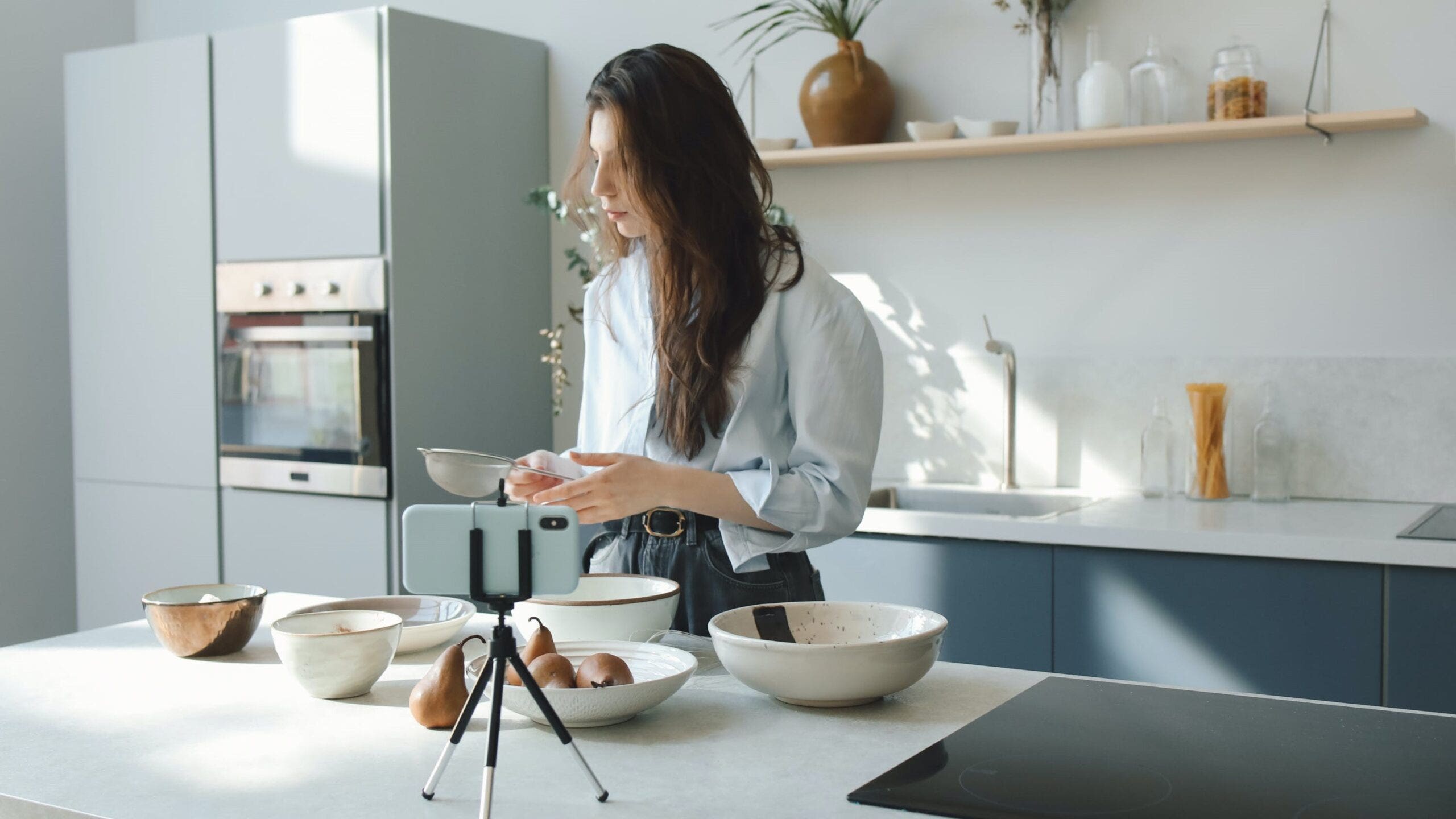
Table of Contents
Show more
Show less
According to a recent study, food blogs had the highest median monthly income out of the major blogging topics. If you have always wanted to share your culinary delights but aren’t sure how to start a food blog, you have come to the right place.
In this guide, we will cover the step-by-step process to start a food blog, right from creating a brand identity and securing a domain name to monetizing your efforts.
Step 1. Brainstorm Your Brand Identity
There are more than 2 billion blogs in the blogosphere. This implies there is fierce competition in this niche and hence having a brand identity is essential to make you stand apart from the crowd. Brainstorming your brand identity must be the first step in starting a food blog.
What Builds Your Brand Identity?
Brand identity is a mix of your niche, the ideal audience you want to attract, the message you want to share with your audience and how visitors experience your brand. You should also think deeply about what you want to achieve out of starting a food blog—not just the business outcome but what will make you happy.
Food is your blogging niche, but it encompasses many different aspects. Narrow down your specific angle by asking yourself a few questions:
- Are you going to post recipes, or talk about food in general?
- Are you going to focus on specific food cultures, such as Mexican or Mediterranean?
- Do you want to talk about food habits or specific diets such as vegan, keto or paleo?
- Do you want to talk about everyday food that is within reach of the common person or focus exclusively on expensive food?
You should also spend some time thinking about how you want your audience to perceive you and your brand—are you speaking as a friend, a guide or a coach? What is your own story related to food that you want to share with your audience?
When you are thinking about your ideal audience, consider not just its demographics but also its behavior patterns, likes and dislikes, family values, common illnesses or health challenges, etc. And of course, you’ll need to come up with a name and tagline that accurately reflects your brand so that this audience feels a connection right off the bat.
Step 2. Secure Your Domain
The next step is to secure your domain name. The ideal scenario is to have a domain name that matches your business name—but if it is taken, don’t panic. There are many businesses out there that have blog names different from their business names. Try to think of a domain name that is as close to your business name as possible and buy it.
Find Your Domain Registrar
To buy a domain name, you will need the help of a domain registrar, a service that sells domain names. When buying a domain name, you need to understand the difference between .com, .net, .org, etc. You also need to check how secure your domain registrar is. Our in-depth article on the best domain registrars includes some suggestions on how to choose the best possible domain name. But before you purchase, take a look at web hosts and website builders. Some of these services include domain registration for free, saving you time and keeping services in one unified platform.
Featured Partners
Starting price
$6.98 Around INR 573.50 for the first year
Renewal cost
$13.98 Around INR 1,148.62 per year
Starting price
$9.99 (Around INR 820 for the first year)
Renewal cost
$19.99 (Around INR 1,642 per year)
Step 3. Host Your Website
After you have the domain name secured, you need to find a service to host your website. Web hosting means you are purchasing an online space where your audience can visit your website and read your content.
A host is essentially a server where all the files associated with your blog or website are kept. There are many web hosting providers available such as HostGator, GoDaddy, Bluehost, Namecheap and more. Some will include domain registration free for the first year.
Step 4. Design and Build Your Blog
Next, you need to design and build the blog to give your visitors an awesome experience. While you could code the site from scratch, this is a resource-intensive and time-consuming process. Hiring a developer will make for a more polished product, but that comes at a high cost. When you’re just getting started, it is quicker and easier to use a drag & drop website builder or a dedicated blogging platform.
Use a Blogging Platform
Utilizing a well-known blogging platform such as WordPress or Drupal is an easy way to get a blog up and running quickly, since they come equipped with many of the tools you’ll need to market your site. As with web hosts, many blogging platforms allow you to purchase a domain name from within their interface.
Use a Website Builder
There are many website builders such as Weebly, GoDaddy, Squarespace and HostGator. These website builders usually offer a drag-and-drop interface so that you can create your own website quickly even if you have no coding experience.
If you want to (and have the budget for it), some of these platforms allow you to hire a professional website designer to build your blog.
Featured Partners
Price per month
INR 169 onwards
Features
Affordable hosting plan, free domain name, free CDN
Price per month
INR 149 per month (for the first three years, INR 99 per month)
E-commerce in entry-level plan
Yes
Price per month
INR 149 onwards
Features
Drag-and-Drop Editor, Free Domain and Unlimited Free SSL
Apply Your Brand Standards
After you have clarity on your brand identity, you need to convert it into tangible assets that can be shared on your website, social media handles and other channels you use to interact with your ideal audience. You need to think about the color palette, font specifications and logo that you want readers to associate with your blog. Both website builders and blogging platforms give you a wide variety of themes to choose from.
Themes are design wireframes that include page layout, colors, typography, background, headers and footers, etc. Themes help you give your blog a consistent look and feel. Most modern themes are optimized for mobile devices, so you don’t need to worry about how your blog will look across devices.
You can choose a theme that matches your brand design and you are ready to go. Since you can customize these themes, matching them to your brand identity should not be difficult.
The one thing to remember while building your blog is that you will not get it right the first time around. Put out a first version of your blog and keep experimenting with the design to see what works.
Step 5. Start Posting
Your food blog is ready and you can start posting. Here are a few tips to keep in mind when you plan, develop and publish a post.
Post high-quality content
Always post high-quality content, whether it’s recipes, restaurant reviews, op-eds on food items or a journey down memory lane. And high quality does not only mean the value you provide in your posts. It also includes readability. Use headlines and subheads that hook the reader. Use a writing style that makes the reader want to keep reading.
Stick to a posting schedule
Fix a day and time to post, and stick to that schedule as much as possible. When you post at a fixed cadence, your audience is ready to consume the content you put out. Also, Google’s algorithm likes sites that post regularly. Of course, how regularly you post depends upon how quickly you can put together a high-quality post.
Use keywords
Keywords are essential for attracting organic traffic. Do keyword research and plan your posts around the keywords your target audience is using. This will help drive organic, unpaid traffic to your website.
Have a variety of posts
The jury is still out on the ideal length for blog posts, so try to mix and match short posts of 1,000 words or so with long ones of 3,000 words or more.
Initially, people do not know about your blog or the awesome posts you are publishing. Even if you are using the right keywords and SEO strategy, organic traffic takes time. So you must start promoting your blog from day one. Opinions are mixed when you ask experts how much you should promote a blog. However, one thing is clear—you must spend more time promoting your blog than you spend creating it.
Here are some tips to promote your blog:
- Pre-schedule your promotion in a social media management tool such as Buffer or Hootsuite
- On the day of publishing, promote your blog two to three times on each platform
- Promote the blog post more during the week
- Promote the blog post every month at least two to three times for the next six months
- After a year has passed, see if you can update the blog to add valuable information and repeat the promotion cycle
- If you have the budget, use ads on social media platforms
- If you have an email list, promote to your subscribers
- Partner with other newsletter writers and promote each other’s content
How To Monetize Your Blog
Studies have found that food bloggers have a median monthly income of around INR 7 lakh, which is the highest among major niches. If you are launching a food blog, you must think about monetizing it in the future.
Some of the most commonly used channels of monetization include:
- Affiliate marketing: You can become affiliate partners of food brands and promote their products through your writing.
Ads: You can build partnerships and run ads to earn money. - Sponsored posts: You can create sponsored posts for food brands. Take care to ensure this would be of interest to your audience, otherwise, it may harm your brand identity.
- E-books: You can easily create ebooks out of your expertise and sell them to your audience. Recycle your most popular posts or get the e-books written by someone else so that you don’t need to invest lots of time in developing these e-books. They can be a good source of passive income.
- Courses: Courses are another way of generating passive income by sharing your expertise with your audience. This is easiest to do if you post recipes or talk about diets.
- Selling products: A food blog is an excellent way to promote your own physical products, whether you sell on your own website or other ecommerce platforms.
You can actively monetize your blog only after your blog reaches a good number of unique visitors per month. However, you should start building partnerships, gaining a loyal following and developing e-books and courses to offer well in advance. The idea is to be prepared when you are ready to start monetizing.
9 Best Practices for Successful Food Blogging
Here are some best practices for you to follow if you want to build a successful food blog.
- Be authentic. If you are posting recipes, post your own. If you are reviewing restaurants or dieting trends or exotic foods, write from firsthand experience.
- Post regularly. Your readers should know when (day as well as time) to expect your blog post. And not just readers—Google’s algorithm also loves your site when you post in a regular cadence.
- Be patient. Growing a blog is a slow process even if you are publishing high-quality posts with awesome pics from day one. Continue posting on your blog even if you are not getting much traction initially.
- Be yourself. Showing your own personality in blog posts is the easiest way to stand apart from competitors.
- Be responsive. When you get comments on your blogs, always respond to them with more valuable content.
- Be courteous. Network with other food bloggers and give thoughtful comments on their blogs. Do not hesitate in promoting others’ content without being asked; soon they will be returning the favor.
- Be creative. Include high-quality pics with your blogs; studies have shown that including more than ten pics in a blog improves results. Including relevant high-quality images should not be a problem for a food blog.
- Be user-friendly. Visitors should be able to follow, share and comment on your blog easily.
- Be resourceful. If you do not already know, start learning search engine optimization (SEO). SEO is a long-term game, so start applying its principles to your blog descriptions, page headings and post headlines from the very beginning.
Bottom Line
If the food industry speaks to your heart as much as it does to your stomach, a food blog may be a great way to monetize that passion. Use these five steps to get your culinary quest up and running with ease.
Frequently Asked Questions (FAQs)
Do food bloggers get paid?
Food bloggers can monetize their food blogs and earn well. Some ways you can monetize your food blog are through sponsored posts, affiliate marketing, launching your own e-books or courses and running ads.
How do I start a personal food blog?
You can start your own food blog by following these steps:
- Identify a topic for the blog
- Brainstorm your brand identity
- Choose a domain name and buy it
- Host your domain
- Build your blog
- Start posting
Can I use other people’s recipes on my blog?
If you want to use other people’s recipes on your blog, provide a link to the original blog prominently. However, it’s better to recreate that recipe yourself, add your own flair, take original pictures and then post it on your blog as your own creation.






